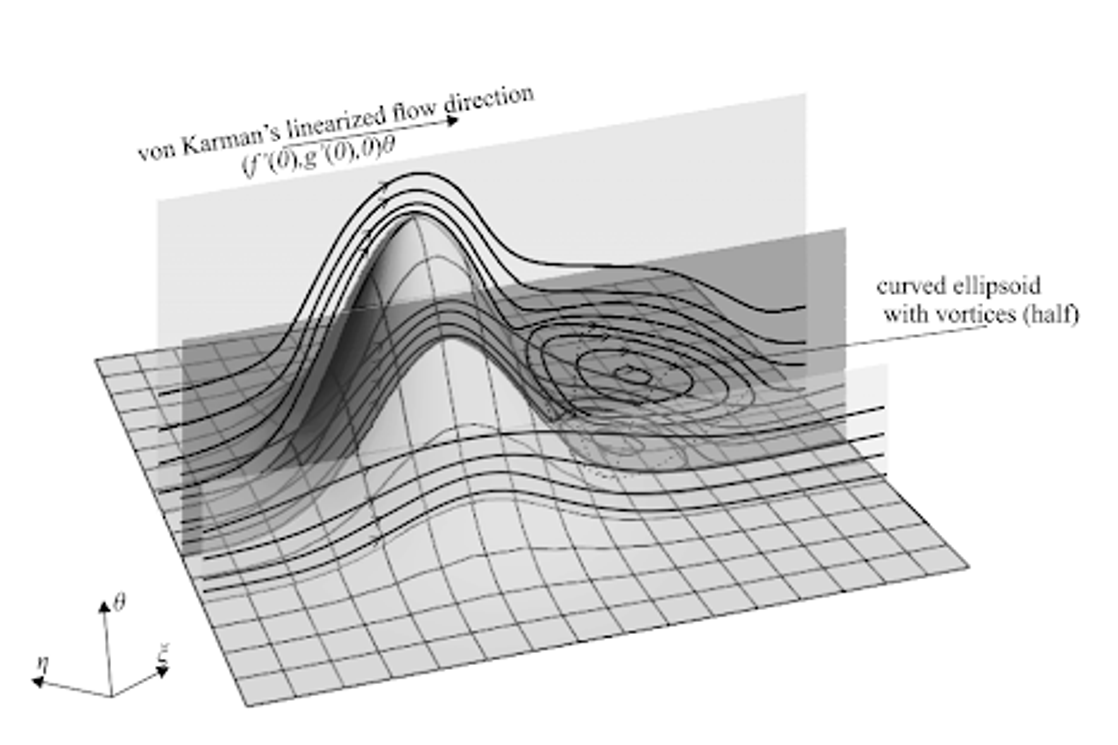HSE Scientist Optimises Solution of Hydrodynamics Problems

Supercomputers are no longer required to calculate fluid flows in multiscale problems.
Roman Gaydukov, Associate Professor at the MIEM HSE School of Applied Mathematics, has modelled the fluid flow around a rotating disk with small surface irregularities. His solution allows for predicting fluid flow behaviour without the need for powerful supercomputers. The results have been published in Russian Journal of Mathematical Physics.
Hydrodynamics studies the motion of fluids and their interaction with solid surfaces. This branch of physics makes it possible to understand and predict the behaviour of fluids and gases under various conditions. In particular, the principles of hydrodynamics are used in electrochemistry for calculating the reactions of galvanisation, such as silver molecules adhering to a metal surface, and oxidation, such as patina formation on copper.
These processes use a disk electrode, which is a flat metal plate that rotates in a fluid. To accurately calculate electrochemical reactions, it is essential to understand how the fluid moves around the electrode and what conditions that need to be maintained. To achieve this, scientists must account for numerous variables, while even minor irregularities on the disk surface can greatly influence fluid flow, leading to complex and unexpected effects.

Earlier studies focused solely on symmetrical irregularities, but a scientist at HSE University examined a more complex case. Roman Gaydukov calculated how fluid flow would change with the presence of asymmetrical irregularities on the rotating disk surface.
To do this, he used the method of multideck structures of boundary layers, making it possible to decompose the three-dimensional problem into a series of two-dimensional ones. This method helps solve complex hydrodynamic problems at high Reynolds numbers, where direct modelling is impossible. Although this method has been known since the late 1960s, a rigorous mathematical formulation was only recently developed by the author of the paper together with Professor Vladimir Danilov. The mathematical algorithm of the method can be integrated into any symbolic computation software.

Roman Gaydukov
'Under real conditions, perfectly smooth surfaces do not exist. We have demonstrated how small irregularities on the disk surface affect fluid flow by creating vortex zones and altering the structure of the boundary layer,' explains Roman Gaydukov. 'Our method allows modelling a problem within a few hours, whereas it could take days or even weeks on a supercomputer. This not only saves time but also reduces the cost of computational resources. The method works effectively for large but finite Reynolds numbers.'
The Reynolds number is a dimensionless quantity that describes the relationship between inertial and viscous forces in fluid flow. A large Reynolds number signifies the dominance of inertial forces, which often results in turbulent (chaotic) flows, while a small Reynolds number indicates the dominance of viscous forces, leading to laminar (ordered) flows.
The developed approach can be used to accurately model fluid motion during chemical reactions, with potentially wide applications in industry.
In the future, the scientist plans to extend his research to more complex systems involving interactions between different phases, such as liquid droplets in an air stream or aerosols. This will enable a deeper understanding of the processes in multicomponent and multiphase systems and help improve existing models.
According to Gaydukov, 'Together with my graduate student Nikita Burov, we plan to investigate how the shape of fluid droplets changes as they move through an air flow and how the droplets, as irregularities—including their potential freezing—affect the flow.'
See also:
HSE Neurolinguists Reveal What Makes Apps Effective for Aphasia Rehabilitation
Scientists at the HSE Centre for Language and Brain have identified key factors that increase the effectiveness of mobile and computer-based applications for aphasia rehabilitation. These key factors include automated feedback, a variety of tasks within the application, extended treatment duration, and ongoing interaction between the user and the clinician. The article has been published in NeuroRehabilitation.
'Our Goal Is Not to Determine Which Version Is Correct but to Explore the Variability'
The International Linguistic Convergence Laboratory at the HSE Faculty of Humanities studies the processes of convergence among languages spoken in regions with mixed, multiethnic populations. Research conducted by linguists at HSE University contributes to understanding the history of language development and explores how languages are perceived and used in multilingual environments. George Moroz, head of the laboratory, shares more details in an interview with the HSE News Service.
Slim vs Fat: Overweight Russians Earn Less
Overweight Russians tend to earn significantly less than their slimmer counterparts, with a 10% increase in body mass index (BMI) associated with a 9% decrease in wages. These are the findings made by Anastasiia Deeva, lecturer at the HSE Faculty of Economic Sciences and intern researcher in Laboratory of Economic Research in Public Sector. The article has been published in Voprosy Statistiki.
Scientists Reveal Cognitive Mechanisms Involved in Bipolar Disorder
An international team of researchers including scientists from HSE University has experimentally demonstrated that individuals with bipolar disorder tend to perceive the world as more volatile than it actually is, which often leads them to make irrational decisions. The scientists suggest that their findings could lead to the development of more accurate methods for diagnosing and treating bipolar disorder in the future. The article has been published in Translational Psychiatry.
Scientists Develop AI Tool for Designing Novel Materials
An international team of scientists, including researchers from HSE University, has developed a new generative model called the Wyckoff Transformer (WyFormer) for creating symmetrical crystal structures. The neural network will make it possible to design materials with specified properties for use in semiconductors, solar panels, medical devices, and other high-tech applications. The scientists will present their work at ICML, a leading international conference on machine learning, on July 15 in Vancouver. A preprint of the paper is available on arxiv.org, with the code and data released under an open-source license.
HSE Linguists Study How Bilinguals Use Phrases with Numerals in Russian
Researchers at HSE University analysed over 4,000 examples of Russian spoken by bilinguals for whom Russian is a second language, collected from seven regions of Russia. They found that most non-standard numeral constructions are influenced not only by the speakers’ native languages but also by how frequently these expressions occur in everyday speech. For example, common phrases like 'two hours' or 'five kilometres’ almost always match the standard literary form, while less familiar expressions—especially those involving the numerals two to four or collective forms like dvoe and troe (used for referring to people)—often differ from the norm. The study has been published in Journal of Bilingualism.
Overcoming Baby Duck Syndrome: How Repeated Use Improves Acceptance of Interface Updates
Users often prefer older versions of interfaces due to a cognitive bias known as the baby duck syndrome, where their first experience with an interface becomes the benchmark against which all future updates are judged. However, an experiment conducted by researchers from HSE University produced an encouraging result: simply re-exposing users to the updated interface reduced the bias and improved their overall perception of the new version. The study has been published in Cognitive Processing.
Mathematicians from HSE Campus in Nizhny Novgorod Prove Existence of Robust Chaos in Complex Systems
Researchers from the International Laboratory of Dynamical Systems and Applications at the HSE Campus in Nizhny Novgorod have developed a theory that enables a mathematical proof of robust chaotic dynamics in networks of interacting elements. This research opens up new possibilities for exploring complex dynamical processes in neuroscience, biology, medicine, chemistry, optics, and other fields. The study findings have been accepted for publication in Physical Review Letters, a leading international journal. The findings are available on arXiv.org.
Mathematicians from HSE University–Nizhny Novgorod Solve 57-Year-Old Problem
In 1968, American mathematician Paul Chernoff proposed a theorem that allows for the approximate calculation of operator semigroups, complex but useful mathematical constructions that describe how the states of multiparticle systems change over time. The method is based on a sequence of approximations—steps which make the result increasingly accurate. But until now it was unclear how quickly these steps lead to the result and what exactly influences this speed. This problem has been fully solved for the first time by mathematicians Oleg Galkin and Ivan Remizov from the Nizhny Novgorod campus of HSE University. Their work paves the way for more reliable calculations in various fields of science. The results were published in the Israel Journal of Mathematics (Q1).
Large Language Models No Longer Require Powerful Servers
Scientists from Yandex, HSE University, MIT, KAUST, and ISTA have made a breakthrough in optimising LLMs. Yandex Research, in collaboration with leading science and technology universities, has developed a method for rapidly compressing large language models (LLMs) without compromising quality. Now, a smartphone or laptop is enough to work with LLMs—there's no need for expensive servers or high-powered GPUs.


